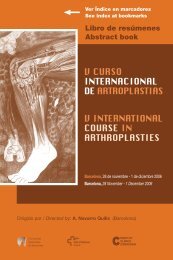Notas / Notes - Active Congress.......
Notas / Notes - Active Congress.......
Notas / Notes - Active Congress.......
You also want an ePaper? Increase the reach of your titles
YUMPU automatically turns print PDFs into web optimized ePapers that Google loves.
MIÉRCOLES / WEDNESDAY<br />
100<br />
27. Ornstein. E, Atroshi. I, Franzen. H, Johnsson. R, Sandquist.<br />
P and Sundberg. M: Early complications after one<br />
hundred and forty-four consecutive hip revisions with<br />
impacted morselized allograft bone and cement. J Bone<br />
and Joint Surg., 84-A: 1323-1328.2002.<br />
28. Raut. VV, Siney. PD, Wroblewski. BM: Outcome of revision<br />
mechanical stem faliure using the cemented Charnley´s<br />
stem. A study of 339 cases. J Arthroplasty. 11:4,<br />
405-10. 1996.<br />
29. Souminen. S, and Santavirta. S: Revision total hip arthroplasty<br />
in deficient proximal femur using a distal loadbearing<br />
prosthesis. Ann Chir Gynaecol. 85:3, 253-62.<br />
1996.<br />
30. Sugimura. T, Tohkura. A: THA revision with extensively<br />
porous coated stems. 32 hips followed 2-6.5 years. Acta<br />
Orthop Scand. 69:1, 11. 1998.<br />
31. Wagner. H: A non allogaft press fit alternative. Current<br />
Concepts in Joint Replacement. Orlando. December 1995.<br />
32. Young-Min Kim, Hee Joong Kim, Won Seok Song, Jeong<br />
Joon Yoo. Experiences with the biocontact revisions tems<br />
with distal interlocking. J Arthroplasty 19 (1):27-33. 2004.<br />
LONG TERM RESULTS IN HA-COATED<br />
REVISION HIP ARTHROPLASTY<br />
Rudolph Geesink MD PhD<br />
Professor of Orthopaedic Surgery, Maastricht University,<br />
Netherlands<br />
The goal of hip revision surgery is to restore longevity of<br />
pain-free function that has been disturbed by one of the<br />
many failure mechanisms in arthroplasty.<br />
Main challenges include:<br />
- provide stable fixation of the new implant<br />
- provide stable joint resistant against dislocation<br />
- restore the bone that has been damaged by osteolysis and<br />
stress-shielding<br />
Progress in fixation biology through the use of HA-coatings<br />
has permitted expanded indications for the use of HA-coated<br />
implants in revision arthroplasty, especially on the femoral<br />
side. HA-coatings have been used in revision arthroplasty<br />
since 1986 in several stages of evolution. The first generation<br />
of implants using HA-coated Omnifit stems with now 20 years<br />
follow-up has resulted in excellent long term survival although<br />
the scope of application was somewhat limited as it is actually<br />
a primary stem. Long term follow-up of 63 cases initially with<br />
average age of 53 years at time of revision surgery and 61%<br />
multi-revisions showed survival rates at minimum 15 year<br />
follow-up of 92%.<br />
Based upon the same design characteristics the evolutionary<br />
HA-coated Restoration stem became available in 1997 with<br />
variable stem lengths and diameters followed by the even<br />
more flexible modular successor in 2005. They have greatly<br />
expanded the versatility and success rate even in complex<br />
revision surgery. Although the numbers have increased,<br />
follow-up is still limited but based on the excellent results of<br />
previous generations where upon its design was based we<br />
can expect excellent and reliable long term results. Initial<br />
complication rate is low and the early mechanical failure rate<br />
is below 2%.<br />
FRACTURAS PERIPROTÉSICAS<br />
DE FÉMUR<br />
Carles Mestre<br />
Hospital de l’Esperança. IMAS. Barcelona (Spain)<br />
TWO- TO FIVE-YEAR FOLLOW-UP OF<br />
MOSTLY TYPE III FEMORAL DEFECTS IN<br />
REVISION THR TREATED WITH THE LINK<br />
MP STEM<br />
Rodriguez JA, Fada R, Murphy SB, Rasquinha VJ,<br />
Ranawat CS<br />
Lenox Hill Hospital. New York (USA)<br />
BACKGROUND<br />
Femoral bone deficiency has been shown to adversely affect<br />
the results of revision THR. Tapered titanium modular stems<br />
allow distal fixation of the fluted, conical portion of the stem<br />
in the remaining bone, and may be a more versatile approach<br />
to fixation in the setting of proximal bone loss.<br />
METHODS<br />
One hundred and two consecutive hips with proximal bone<br />
loss underwent revision femoral reconstruction between 1998<br />
and 2002 at 3 centers using the Link-MP modular stem. Fortythree<br />
hips had Mallory Type 3C femoral deficiency. Ninety-





